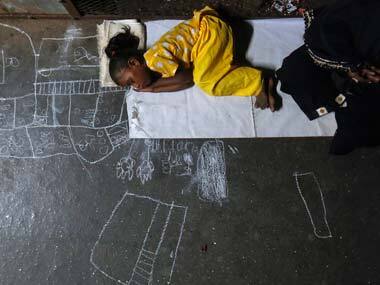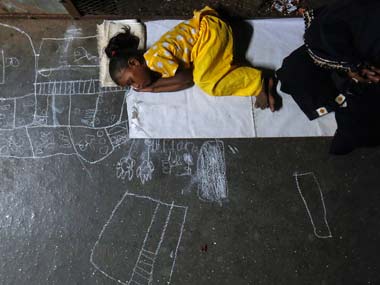Editors note: The headline of this copy erroneously said Bundelkhand instead of Bulandshahr. It has been changed now. We regret the error. It takes a special kind of savagery to do this: to take a ten year old child who comes into a police station after having been raped, and lock her up in the station’s holding-pen. To watch, as she tries to reach out through the cage’s wires, as a local journalist records her presence on film. Watch the video here:
Perhaps, then again, it doesn’t. Earlier, children, aged between 10 and 12, were paraded on the streets of West Bengal’s Asansol, beaten with electric wire and tied to bamboo poles—all this in front of police—because they stole from the local market. I’m guessing few people even remember the four year old raped in Chinchwad, the ten year old Valsad girl raped by her uncle or the Latur teenager who was raped by three young men in her village, and then hanged from a Jamun tree. India treats its children worse than animals, every single day—but there’ve been no mass protests at these outrages, no sit-ins targeting the chief minister, not even a candlelight vigil at India Gate. The Supreme Court has now stepped in, demanding an explanation for the Bulandshahr outrage. It is too easy, though to blame the police officers—women, parenthetically—for this. The officers responsible, guilty as they are of serious crimes, ought be marched out of their uniforms and into prison—but we must accept they reflect the values and attitudes of the societies they are drawn Leave aside having worse child-nutrition statistics than sub-Saharan Africa, our failure to ensure primary education for all; the persistence of child labour—Indian children’s lives aren’t about school or playgrounds, but physical violence, emotional abuse and rape. This is the way it is, because we as people do not care enough to change it. Back in 2007, the Union Ministry of Women and Child Development released a terrifying study of how we treat our children. Fifty three percent of the children, the Study reported, said they had encountered “one or more forms of sexual abuse”; 68.99 percent said they had encountered physical abuse. More than a fifth reported severe sexual abuse, including assault, having been compelled to fondle adults’ private parts, exhibit themselves, or photographed nude. Well over half of those reporting severe sexual abuse, the study found, were boys. Nearly three out of four children polled reported having been physically abused—kicking, slapping or corporal punishment. In all thirteen states covered by the Study, the incidence of physical abuse directed at children was above 50 percent. The worst victims were the very young. Forty-eight percent of respondents who reported physical abuse were between five and twelve years old, while 26.29 percent were thirteen or fourteen years old. “In all age groups”, the Study states, “an overwhelming majority of children (65.01 percent) reported being beaten at school”. [caption id=“attachment_693480” align=“alignleft” width=“380”]  Representational image: Reuters[/caption] Indian homes, the data showed, weren’t any safer than schools. Fifty-three percent of children not going to school said they had been sexually abused in their family environment. Just under half said they had encountered sexual abuse at their schools. Most vulnerable were children in workplaces; 61.31 percent of whom had been sexually abused. In all but four of thirteen states—Gujarat, Madhya Pradesh, Delhi and Maharashtra—boys were found to be more at risk of sexual abuse than girls. In Delhi, a staggering 65.6 percent of boys reported having been sexually abused. The study’s findings have been corroborated by several other independent researchers. Maulana Azad Medical College’s Deepti Pagare had found that over three fourths of children in Delhi’s Child Observation Home had reported being subjected to physical abuse. Fathers made up over half the reported perpetrators. Save the Children and Tulir, in a 2006 study conducted in West Bengal, found almost three-quarters of child domestic workers had been physically abused. We know, from separate studies, that the use of children in prostitution is also widespread. In their 2005 study on the trafficking of women, S Sen and PM Nair estimated that there are up to half a million girl children from across the region working as prostitutes in India. There is no doubt that children across the world are subjected to horrific levels of violence. In the United Kingdom, 5.9 percent of under 11s and 18.6 percent of 11–17s reported severe maltreatment, including contact sexual abuse. In the United States, a staggering 676,569 victims of child abuse and neglect were reported in 2011—more than 9 out of every 1,000 children in the population. Hideous as these figures are, they are still well below the levels the Government of India’s Study suggests are prevalent in our country. Moreover, years of sustained efforts in the United States has driven down child sexual abuse levels over 60% from 1992, survey data shows.
This we know: child abuse scars its victims for life. Neurological research is giving us insight into what abusers inflict on their victims. In 2009, Michael Meaney and his team at Canada’s McGill university found that child abuse left markers on victims’ genes, which made them more likely to commit suicide as adults.
Martin Teicher at MacLean Hospital in Belmont led a team of researchers who found victims’ hippocampus’s shrank, leaving them more at risk of depression, schizophrenia and post-traumatic stress disorder. Women abused early in their lives are more likely to smoke, suffer from gestational diabetes and have premature babies or children with autism. In India, though, we’re barely even beginning to talk about the problem. There’s a high-minded draft national policy on children, which mandates that “children are to be protected from all forms of harm, abuse, neglect, violence, maltreatment and exploitation”. Parliament, institutions, the media and, most important, our society, haven’t found the time to discuss or implement any of these things. The country’s criminal justice system simply doesn’t have either the legal instruments or police infrastructure to deal with crimes against our children. Despite calls from campaigners and child-rights groups, India is yet to pass a specific law dealing with sexual and physical violence against children—making prosecutions in many situations almost impossible. Perhaps this shouldn’t surprise us. India is an extraordinary permissive society when it comes to perpetrators of sexual crimes. Remember the venerable Justice Markandey Katju and Justice Gyan Sudha Mittal letting off gang-rapists Baldev Singh, Gurmail Singh and Hardeep Singh after they agreed to pay a fine of ₹.10,000, because the convicts and the victim were now happily married to different people and “wanted to live peacefully”. The kids will get over it, right? Few pre-industrial societies understood the value of treating children in a humane fashion: it wasn’t until 1842, after a string of disasters, that the United Kingdom legislated to stop kids under 10 working in coal mines. The great Italian intellectual Antonio Gramsci documented the costs for Europe. Fascism, he argued, arose in a society “where mothers educate their infant children by hitting them on the head with clogs”. It is perhaps no wonder, our child abuse statistics show, that we inhabit a society where lathis are the preferred mode of argument. How we behave—with women, with men—is taught. The ways we educate our children shapes the society we live in. In Indian society today, violence is not an aberration; it is the tie that binds us.


)
)
)
)
)
)
)
)
)



